Tyrnau (Steiermark): Difference between revisions
Jump to navigation
Jump to search
Knorrepoes (talk | contribs) m (Text replace - "Österreich" />" />" to "Österreich" />") |
Knorrepoes (talk | contribs) m (Text replace - "[[Literature" to "{{media}} [[Literature") |
||
| Line 16: | Line 16: | ||
Tyrnau means "duerre Au" (a dry place; a place, where water is scarce). Nevertheless, this part of the Styrian mountains was well-populated until the 19<sup>th</sup> century. Now, more than 80 % of land in the area is wooded. There is a strong population of ibex here, which makes Tyrnau an attractive place for nature lovers. The wood and the ibex have been included in the arms. | Tyrnau means "duerre Au" (a dry place; a place, where water is scarce). Nevertheless, this part of the Styrian mountains was well-populated until the 19<sup>th</sup> century. Now, more than 80 % of land in the area is wooded. There is a strong population of ibex here, which makes Tyrnau an attractive place for nature lovers. The wood and the ibex have been included in the arms. | ||
{{media}} | |||
[[Literature]] : Image provided by Karl Palfrader (k.palfrader@aon.at), MStLA 36 (1986), p. 70 | [[Literature]] : Image provided by Karl Palfrader (k.palfrader@aon.at), MStLA 36 (1986), p. 70 | ||
Revision as of 07:14, 9 July 2014
| Heraldry of the World Civic heraldry of Austria - Österreichische Gemeindewappen |
TYRNAU
State : Steiermark
District : Graz-Umgebung
Origin/meaning
The arms were granted on February 18, 1985.
Tyrnau means "duerre Au" (a dry place; a place, where water is scarce). Nevertheless, this part of the Styrian mountains was well-populated until the 19th century. Now, more than 80 % of land in the area is wooded. There is a strong population of ibex here, which makes Tyrnau an attractive place for nature lovers. The wood and the ibex have been included in the arms.
Contact and Support
Partners:
Your logo here ?
Contact us
© since 1995, Heraldry of the World, Ralf Hartemink 
Index of the site
Literature : Image provided by Karl Palfrader (k.palfrader@aon.at), MStLA 36 (1986), p. 70











